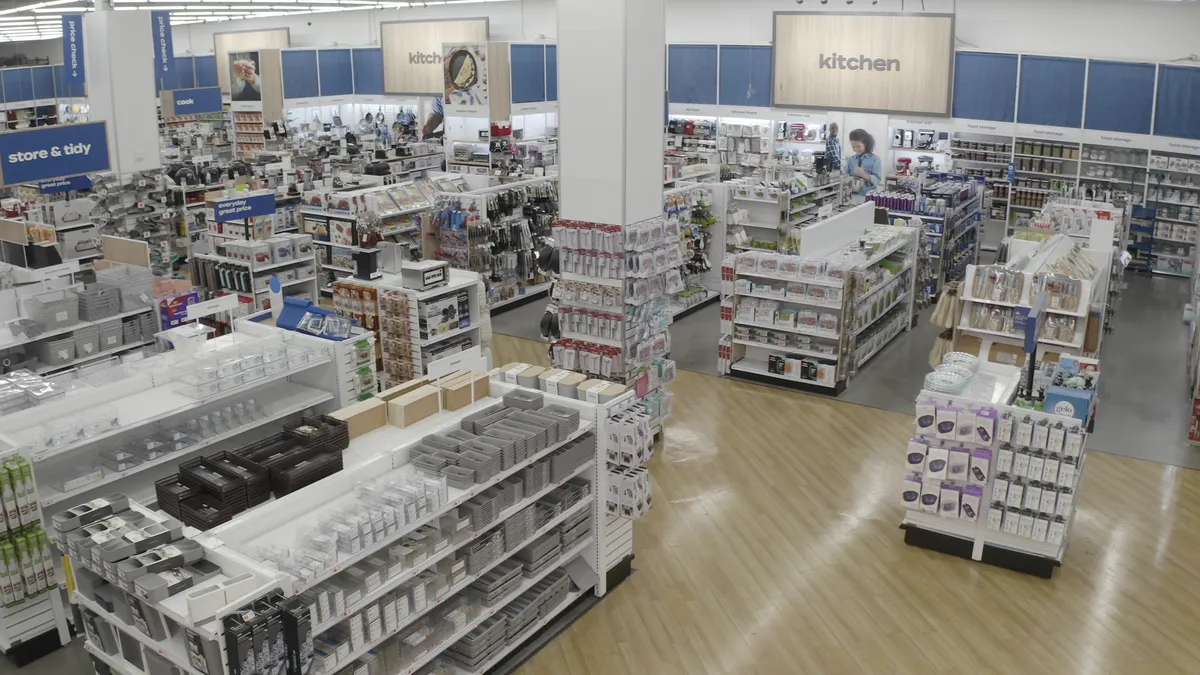Bed Bath & Beyond’s supply chain team is in for a year of change.
COO John Hartmann and the company’s leadership made their case for a more modern Bed Bath & Beyond last year at an investor day conference that featured a plan to pack many years worth of supply chain transformation into three.
"We are asking our supply chain teams to really pivot quickly," Hartmann told Supply Chain Dive in an interview after the retailer released quarterly results Thursday.
Store-level services like curbside pickup and buy online, pick up in store are part of the solution the retailer has drawn-up, and deep back-end reorganization is on the docket as well.
Precise inventory management across the chain is gaining importance, with digital orders increasingly being fulfilled from stores. In the quarter ending Nov. 28, Bed Bath & Beyond fulfilled 36% of digital orders from stores and boosted total digital sales 94% YoY, making progress toward its goal of "omni-always" operations.
"This muscle was not in place last year," said Hartmann on Thursday's call with analysts.
Flexing new muscles
Bed Bath & Beyond has a store replenishment model that revolves around 30 cross dock facilities that consolidate vendor shipments. The company has four warehouses to ship e-commerce orders.
Those 30 cross docks will drastically reduce in number soon, making way for a network of distribution centers, run by one or more third parties, Hartmann said — the request for proposals are in review even now. Historically, stores had to wait 35 days for replenishment orders. Reducing that down to the 10 days Hartmann is targeting with the new distribution model should feel to supply chain managers inside the company like a shift into hyperdrive — and with fewer total facilities to manage.
"It is a meaningful pivot for Bed Bath & Beyond. However, these are very well known and very well exercised capabilities by others in the industry today."

John Hartmann
COO, Bed Bath & Beyond
Hartmann said outsourcing the distribution centers will fill in gaps in his team’s expertise.
"What we're looking for is a partner who understands our business and has the competencies and capabilities that we don't have today ... It makes both financial and partnership sense to use someone's capabilities as opposed to try to build them yourself," said Hartmann, who came to Bed Bath & Beyond in May after serving as CEO of True Value.
A supply chain overhaul during a pandemic could be a daunting prospect, with plenty of continuity risk baked in. But Hartmann said the tried and tested model — already common throughout retail for years if not decades — takes out much of the risk.
"This is a very common-sense model. It is four walls distribution, supported by control tower technology, which will give us end-to-end visibility of the flow of products from our vendor partners, right through our stores to and ultimately to our customers … It is a meaningful pivot for Bed Bath & Beyond. However, these are very well known and very well exercised capabilities by others in the industry today."
Near-term logistics headwinds and tailwinds
In the most recent quarter, shipping costs took a sizeable bite of Bed Bath & Beyond’s margins — estimated at 80 basis points. The retailer’s primary carrier FedEx put in place peak surcharges on Ground volume (among other services) in June, which Hartmann said upped shipping costs with that carrier by 20%.
Ground Residential surcharges are set to expire Jan. 17, but parcel experts have conjectured they may be extended before the deadline.
"The freight pressure across retail is here to stay, and we've built that into our future plans."

Mark Tritton
CEO, Bed Bath & Beyond
During the most recent quarter, the retailer established relationships with national and several regional carriers to take additional volume. But the extra capacity, said Hartmann, was more about securing the needed service than keeping control of costs.
Throughout the holiday season, shippers reported canceled pickups and slashed volume allowances from UPS and FedEx. Wedbush analysts estimated that parcel carrier delays pushed roughly 2% of sales from the Bed Bath & Beyond’s fiscal Q3 sales to fiscal Q4.
"The freight pressure across retail is here to stay, and we've built that into our future plans," CEO Mark Tritton said Thursday.
High sales volume could help Bed Bath & Beyond in its transition and wring out greater efficiency in the supply chain. But, GlobalData Managing Director Neil Saunders said it may not last as the pandemic slowly winds down over the next year.
"In our view, we think a lot of the current performance is reliant on a frothier market rather than being driven by underlying changes that the group has made on the ground," said Saunders via email. "This is not to suggest that the changes being made by Mark Tritton and his team are not right, nor that they won’t deliver over the longer-term – we actually believe that they are and that they will – but, like most strategic programs, that change will take some time to produce sustainable, deep-rooted results."
The supply chain overhaul, an expected $250 million investment, is part of the equation that will bring Bed Bath & Beyond back to sustainable growth, according to executives.





















